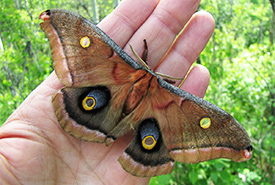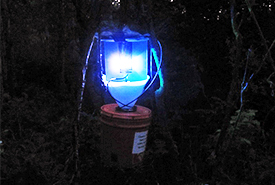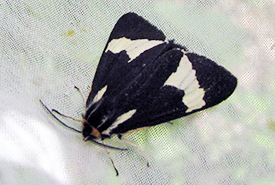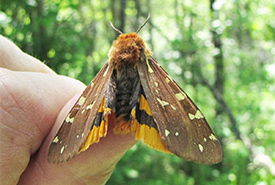Shining a light on moth diversity
Alberta lepidopterists make discoveries sampling moths at NCC properties
Polyphemus moth (Photo by Greg Pohl)
Moths might not be as widely adored as their butterfly relatives, but they are diverse, ecologically important and beautiful in their own right.
So affirms Greg Pohl, professional entomologist and moth enthusiast.
Many moths appear as “drab little bugs” at a glance, but a “tiny world of beauty” emergences when they are viewed under a microscope, says Greg, whose knowledge and passion for these small creatures has steadily grown over the 30 years or so that he has studied them.
Moths: a final frontier
This summer, Greg joined members of the Alberta Lepidopterists’ Guild to sample moths at a Nature Conservancy of Canada (NCC) property in central Alberta. These ongoing efforts are a volunteer initiative to help better understand patterns of moth diversity throughout Alberta, much of which is unknown.
Sampling insects, such as moths, is a chance to explore one of the last frontiers of the natural world, says Greg. “There are such vast numbers of insect species, and a lot of them have not even been discovered yet,” he says.
That means each time the team heads out, there is a good chance they will make a new discovery.
“Often enough, we find things that weren’t known to exist in Alberta or even Canada before,” says Greg.
Head toward the light
The way moths are sampled is simple: by light traps, which feature battery-powered ultraviolet light combined with a container, and that are deployed overnight. Moths are attracted to the light, fall into the container and get stuck inside.

A light trap used to sample moths (Photo by Greg Pohl)
The next day, researchers collect the traps and the specimens inside.
Deploying these traps has gotten easier over the years. Before, Greg would have to carry a heavy motorcycle battery out into the field to power the light. But now, with the advent of energy-efficient LEDs, lightweight battery packs do the trick.
To the laboratory!
Once collected, the moths are transported back to the laboratory for sorting and identification.
Some species can be recognized right away, but many require close inspection under a microscope or even DNA analysis.
The number of species the researchers find is often remarkable. “It’s not unusual to have 500 species or so at one property,” says Greg.

Wood tiger moth (Photo by Greg Pohl)
Each sample’s lasting legacy
Once identified, the specimens are added to a public collection, to support future research and education.
“They’ll be held there forever,” says Greg. “Sometimes people will take another look at these specimens, and maybe 20 or 50 years later, decide there was a new species hiding in there that we didn’t recognize.”
Information about each specimen, including the species and where it was collected, is added to NatureServe, an online biodiversity database, making it available to researchers worldwide. This data can then be used to better understand the timing and distribution of each species, inform conservation planning and even help predict the impacts of climate change.
Just flip a switch
Anyone can help sample moths and close information gaps about these remarkable organisms.
“It’s as easy as turning on a porch light and just seeing what comes in,” says Greg, who has logged hundreds of species by way of his own backyard light.

St. Lawrence tiger moth (Photo by Greg Pohl)
Information collected by everyday people using community science platforms, such as iNaturalist, is changing the world of entomology, says Greg. “It’s been nothing short of revolutionary,” he says. “In my work, I have mined records from iNaturalist, and I have found new provincial and national records of insect species there. It’s really valuable data.”
If you would like to join in the hunt for moths and contribute to humanity’s understanding of the natural world, consider signing up for NCC’s Big Backyard Bioblitz, being held July 28 to August 1.




